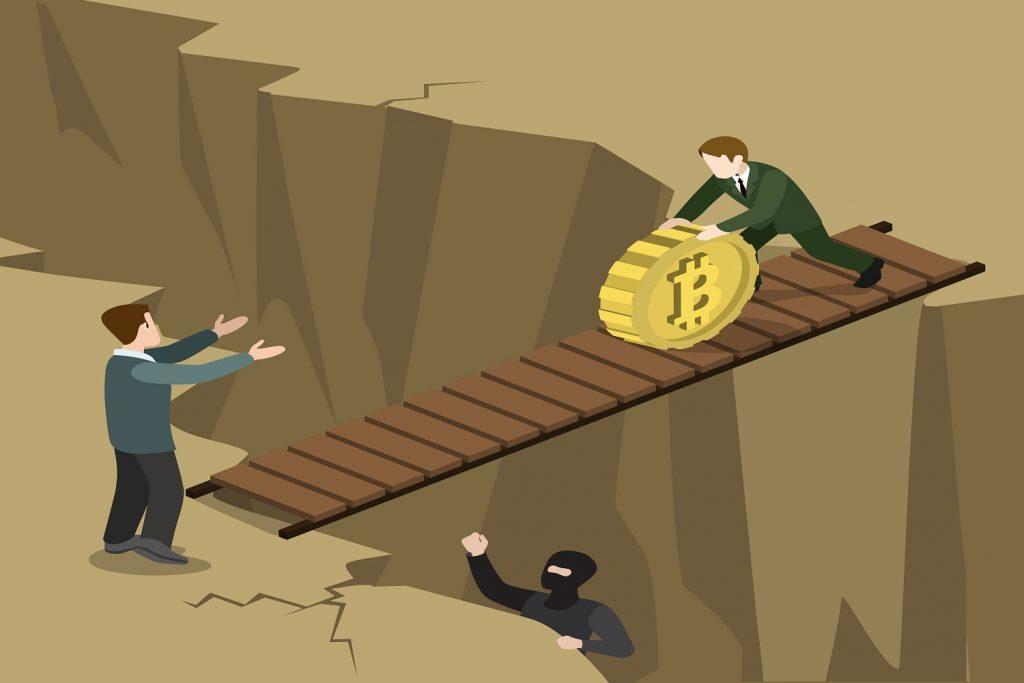Since the inception of Bitcoin in 2008, blockchain technology has advanced significantly. Blockchain networks are increasing in size and number but are still largely isolated from one another, with a persisting inefficiency of interoperability among themselves.
Blockchain bridging, usually referred to as a cross chain bridge, enables you to move data and digital assets between blockchains. The knowledge of blockchain bridge is essential to transfer cryptocurrency between blockchains. This article assists in exploring the fundamentals of crypto bridges, their uses, and how they operate.
What do you mean by blockchain bridging?
Blockchain bridging enables communication between two or more different blockchains. It connects two distinct blockchains and functions exactly like the ones we are familiar with in the physical world.
A blockchain bridge connects two blockchain ecosystems, much like a real-world bridge connects two actual locations. Bridges help blockchains communicate with one another by transferring data and assets.
How do blockchain bridge works?
Crypto bridge protocols allow interactions between two blockchains that are economically and technologically distinct. These protocols serve as a virtual bridge connecting various blockchain ecosystems. Technically, a user who uses a crypto bridge to move their cryptocurrency to another blockchain does not receive the same coin or token they sent.
Instead, the user receives a token correlated to the value of the transferred tokens by the new blockchain, signifying the amount of cryptocurrency they contributed to the bridge. The “lock-and-mint” and “burn-and-release” processes ensure consistent distribution of the number of tokens and their price across the two chains.
For example, When someone has bitcoin and wants to send some of it to Ethereum, the blockchain bridge will retain their coin and generate equivalents in ETH for them to utilize. None of the concerned cryptocurrency moves.
Instead, the total amount of BTC is locked in a smart contract, and a person can access an equivalent amount of ETH. Any remaining ETH will be burned when you want to convert back to BTC, and you will get an equivalent amount of BTC in your wallet.
Why do we need blockchain bridges?
Blockchain networks rely on their communities and norms for governance because they are decentralized. The network’s infrastructure is built to support a stand-alone environment, although data saved on the chain is observable.
The isolated nature of blockchain technology creates hindrances in the development of DeFi and other decentralized applications. As a result of the absence of linkage between different chains, the technology is constrained rather than leveraging the functions of various dApps to promote growth.
What types of blockchain bridges are there?
Types of blockchain bridges often come with common questions like, what is a bridge Ethereum or bitcoin use for interoperability? Here is a list of the most well-known blockchain bridge options you can use to move assets and data between blockchain networks.
Trusted bridges
Crypto bridges that work according to a centralized approach are called trusted bridges. When using trusted bridges, users must rely on the federation members to verify and confirm transactions when converting coins into another cryptocurrency.
Trustless bridges
Decentralized bridges that rely on machine algorithms to function are known as trustless bridges. Individual networks participate in transaction validation on this kind of bridge, imitating real blockchain.
Unidirectional bridges
As their name suggests, unidirectional bridges can only guarantee irreversible and one-way asset transfers from one network to another.
Bidirectional bridges
These bridges can efficiently transfer assets to and from two blockchains, such as the Multichain bridge. For example, with the help of bidirectional bridges, you can send Ethereum to Solana, and in the same way, you can send Solana to the Ethereum blockchain.

List of blockchain bridges
- The syscoin-Ethereum bridge is a trustless bridge that helps interoperability between Ethereum and the Syscoin network. Syscoin grants ERC-20 tokens access to a “zero-confirmation directed acyclic graph,” a real-time, interactive settlement protocol capable of massive 60,000 transactions per second.
- RSK is a platform for second-layer smart contracts running on the Bitcoin blockchain. The RSK bridge effectively introduces interoperability between Bitcoin and Ethereum by allowing assets to move between RSK and Ethereum.
- Avalanche Bridge is the best blockchain bridge that serves as a two-way asset transfer bridge between the Avalanche and Ethereum networks. Additionally, the Avalanche Bridge supports the capabilities of ERC-721 and ERC-20, a type of bridge NFT also relies upon for transfer.
- The Wormhole crypto bridge portal is a worldwide, decentralized communication system that links to several blockchains. It enables unlimited asset transfer between several blockchains, including Terra, Solana, Polygon, Avalanche, Oasis, Ethereum, Binance Smart Chain, and others.
What are some benefits of blockchain bridges?
Interoperability between blockchain
The foremost benefit is enhanced interoperability. Bridges enable communication not only between specific blockchains but also between the parent chain and the child chain. The interoperability of bridges facilitates the blockchain and speeds up widespread adoption.
Flexibility
Users can move critical data and valuables from one blockchain to another via cross-chain crypto bridges. All users enjoy the advantages of many blockchain technologies rather than being constrained to those of a single chain.
Efficiency
Users can enjoy the flexibility of transferring their assets using bridges between non-scalable and high-performance blockchains, taking advantage of costs and the strength of Ethereum smart contracts. Even micro transactions are efficient and without the concern for inflated fees.
Scalability
Network scalability increases significantly via cross-chain crypto bridges. The bridge links the primary and secondary chains allowing it to spread the transaction load across its ecosystem.
What are the risks involved in blockchain bridges?
Smart contract risks
A simple, smart contract allows for an efficient crypto bridge swap. The significance of smart contracts for bridge development cannot be understated. It is especially true for decentralized bridges. Poor design and opalization of smart contracts may become vulnerable to malicious parties.
One such instance is the Wormhole token bridge hack in which a hacker successfully stole 120,000 wETH by taking advantage of weak points in smart contracts. Blockchain bridge hack is one of the significant risks involved in blockchain bridges.
Custodial risk
Users of custodial bridges may be subject to custodial risks. The central organization can hide a custodial bridge to sponge off user assets.
Bottleneck
Transaction rate bottlenecks are an additional potential technical constraint. The transfer capacity limit of a single chain may hamper large-scale blockchain interoperability.
Scalability issue
A bridge can help a busy network become less congested. Still, shifting assets to a different chain won’t address the problem of scalability because consumers will only sometimes have access to the same collection of dApps and services.
What is the future of blockchain bridges?
The ecosystem of Blockchain bridges is changing quickly, and the number of assets and blockchains now supported by at least one bridge is rising exponentially. By bridging the gaps across distinct chains, these platforms pave the way for an industry that develops jointly rather than separately.
For example, the Blockchain business bridge (BBB) is a project trying to establish a knowledge exchange and a global business platform between China, Denmark, and the rest of the world. It has a strong background in both business and research.
As a result, BBB serves as an incredibly reliable launching pad for blockchain actors from nearly every industry, including logistics, finance, food and agriculture, public service, and more. It proves that the future of blockchain bridges is progressive and bright.
Conclusion
Lastly, cross chain bridge crypto transfers are still challenging and expensive even though the tools that bridge blockchain are powerful. The concept of bridging crypto ecosystems is yet to achieve perfection. Even so, Blockchain bridges are a step toward building an open Web 3.0 where many networks can interact and operate effectively. As a result, it is fair to anticipate substantial innovation and development in blockchain technology. Blockchain can become much more adaptive and effective by utilizing bridges.






